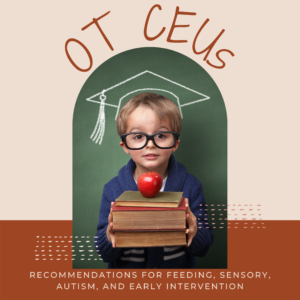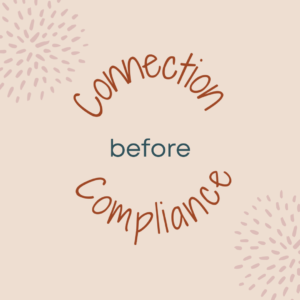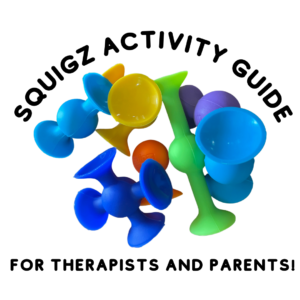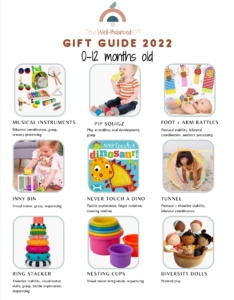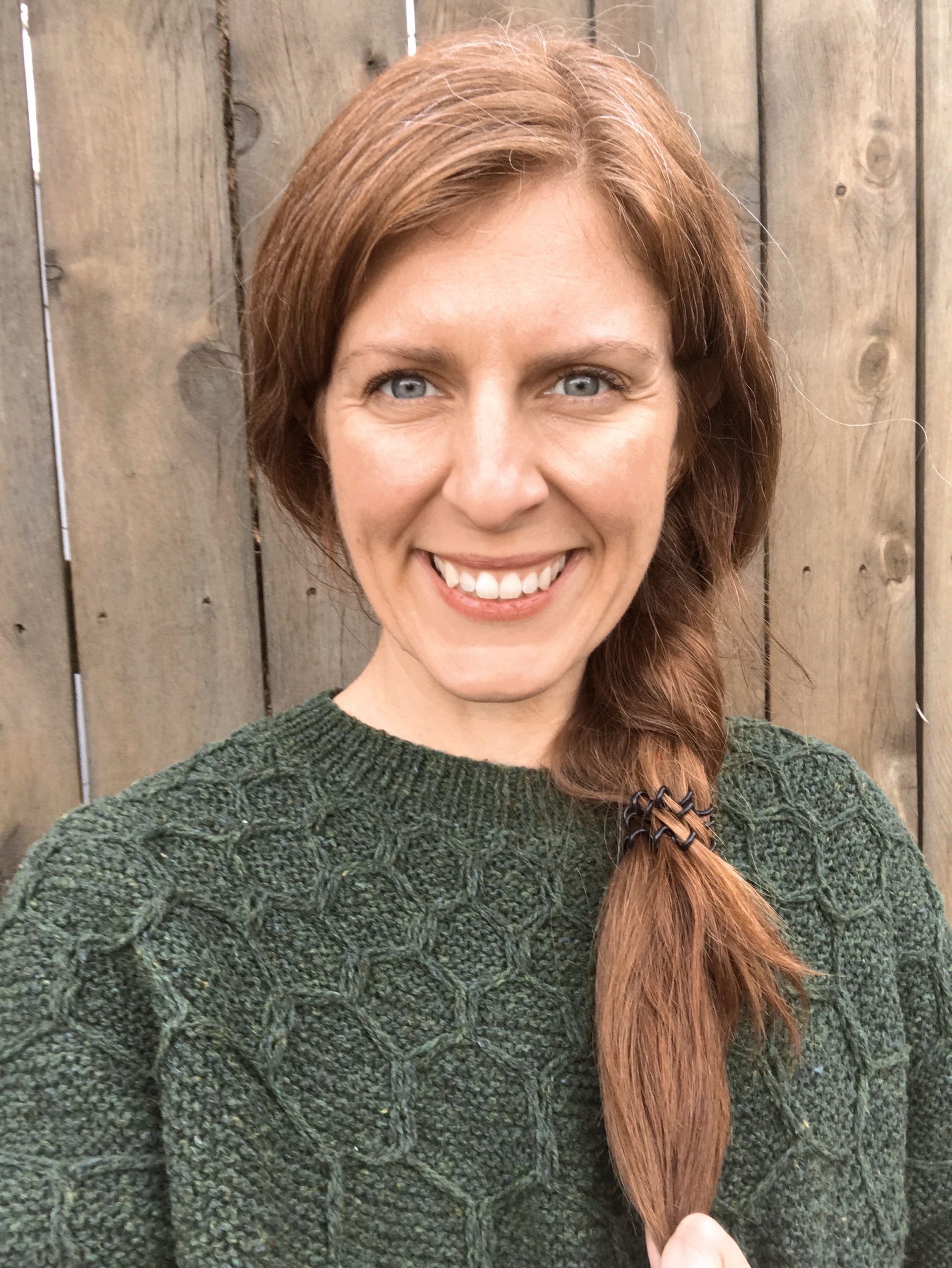Don’t know where to start when picking a course? We’ve all been there.
As an Occupational Therapist, choosing which Continuing Education Courses to sign up for to earn those CEU’s can be overwhelming. There are so many options. So many courses. So many things to learn.
In my previous post, I shared all about my journey to becoming an Occupational Therapist. Typically, graduate school can last anywhere from 2-3 years. You’ll complete your classes, fieldwork, observations, and self-directed learning on your way to graduation. After all that time and money, you’d think you’d know all there is to know about OT. FALSE. Grad school only gives you the basics. The journey doesn’t stop. Our licensing boards typically require we maintain competence, and to do so, we take classes. We have a lifetime of continuing education courses to increase our knowledge base, confidence, and areas of expertise. But where do we start? Keep reading for some of my favorites.
If you’re already an Occupational Therapist or studying to be one, then you know that OT’s can do a lot.
Areas of Practice for an OT:
- In-patient Rehab
- Acute Care
- School-Based
- Early Intervention
- Out-patient Clinics
- Sensory Integration
- NICU
- Pelvic Floor Work
- Lymphedema management
- Mental-Health (psych wards, justice system)
- Feeding Therapy and Eating Disorders
- Tethered Oral Tissue Management and Wound Care
- Hand Therapy and Splinting
- Ergonomic Education
- Driving and Community Rehab
- Environmental Modifications
Take it a step further and there a 100’s of classes you can take for each specialty area.
I have worked in Pediatrics my entire career, so all of my CEU’s are related to that field. I’ll break down the courses by practice area and priority. One of my favorite things to do is search through courses, so I will include coursework I have not yet taken but is on my list.
CEUs for Reflex Integration and Motor Patterns:
MNRI (Masgutova Neurosensorimotor Reflex Integration) – Dynamic and Postural reflexes:
This was one of the best courses I have ever taken. They breakdown all the signs of an unintegrated postural reflex and then teach you how to integrate through mostly passive movements. Some may find the exercises are not “functional” enough themselves, but I like to think of the movements as preparatory for functional tasks. The course is expensive and long (4 days when I took it), but I learned so much and still use the movements in my daily practice. If you are working with babies and toddlers the passive movements are ideal since the cognitive skill to follow verbal commands is limited with this age group.
Vital Links – Building Blocks to Sensory Integration:
This course looks at sensory integration AND reflex integration. Personally, I find this course less comprehensive than the MNRI one. It’s a 2 day course that provides you with more active and functional ways to integration reflexes, which useful for some of my older kids.
Two days of NDT baby Treatment:
This course is specific out of Chicago, but there are similar NDT courses that teach you basic movement patterns for infants and handling techniques. It was a great breakdown of what we should expect for each month of age in motor, sensory, and oral development.
CEUs for Sensory Processing:
Cl-ASI – Certification in Ayres Sensory Integration:
Sensory Processing and Integration can be confusing, but that doesn’t mean you should ignore it. If there is a motor delay, there likely is a sensory delay. Even if you do not work in a sensory integration clinic, you should have the sensory knowledge to help you understand WHY a child has the deficits they do. This course helps you put all those puzzle pieces together. The course was developed by those who worked directly with Jean Ayres and have a wealth of information to share. You’ll review the SIPT and learn the EASI, the new Sensory Integration assessment that will be coming out this year (2021). While this course is expensive and is conducted over the course of a year(ish), it will transform your practice and approach.
Supporting Infant and Child Development through Sensory Integration:
I’m not sure if this class is currently available as it was held by Suzanne Smith Roley, who is now working on the CL-ASI program. It was also a great course that dived into state regulation, arousal, motor skills, and praxis of infants. If you are working in Early Intervention this would be an amazing course to take.
TheraPeeds:
Julia Harper’s courses are specifically tailored to OT’s ranging from beginners through advanced. I have not taken these either, but have heard nothing but good things about them. The courses range from a focus on arousal level and sensory modulation to how it all impacts self-regulation. Then what we as OT’s can do to help support our clients throughout their day with sensory “meals” and “snacks”.
CEUs for School Based Therapists:
Handwriting without Tears:
If you plan on working in a school system, this is an easy 2 day course that will provide you with all the books and resources you need to start the Handwriting without Tears curriculum. Can you teach the program without the training? Sure, but you probably wont understand why they use only 2 lined paper or how they transition between line sizes. You also won’t score all the training books, teacher guides, letter blocks, chalk board and everything else that comes with the training. Also, I absolutely love their handwriting assessment (The Print Tool), which they have a course on as well.
CEUs for Feeding and Oral Motor:
Feeding Therapy: A Sensorimotor Approach:
This is one of the courses I have not taken, but I have read the book that corresponds to the teaching. I have also taken the TOTS course that teaches some of the elements of this course. Oral motor skills are not something OT’s are often taught about in school. In my first few years of practice, it still wasn’t something I felt like I was an expert on. This book gave me the baseline I needed to help understand all the other elements being taught in some of the higher level courses I was taking. I honestly would recommend that this course be taken prior to SOS, TOTS and Beckman. Laurie Overland looks at sensory and motor together and how it impacts function.
Melanie Potock’s Feeding Development:
This course combines 3 courses: The Picky Eating Course, Pediatric Nutrition Course, and Pediatric Feeding Disorders and Anxiety. This is a great course if you are just starting out or want to make your way into the feeding realm. You’ll learn how to assess mealtime positioning, the proper utensils to use, and look at the nutritional breakdown of foods and how we might want to serve them (pouches vs. not). There is also an introduction to tongue ties and a look at how anxiety impacts so many of our picky eaters. It can be taken virtually at your own pace, so a super easy one to do from home. Melanie has a vibrant Instagram page that is a wealth of knowledge. Definitely follow her!
SOS Approach to Feeding:
The Gold Standard in feeding therapy. While I think it’s an excellent course with lots of research to share, I wish I had more oral motor knowledge before taking it. They focus on the progression of food intake and where the breakdowns might happen, the sensory component behind feeding challenges and how to approach feeding therapy using their model. SOS teaches you play-based ways of engaging with food and breaks down all the steps to eating (there are over 30 of them). After you’ve taken the core class, you are able to take any of the advanced on-demand courses that go into specific treatment strategies for various populations.
Functional Assessment and Remediation for TOTS:
Another one of my favorite courses. Tethered Oral Tissues can occur at the tongue, lip, or cheeks. This course teaches you how to assess (it’s so much more than asking a child to stick out their tongue) and how to treat. The information is presented in a way that’s easy to digest and will make you want to look inside every one of your client’s mouths to assess for a tie that may be impacting functional skills (eating, drinking, speech, breastfeeding, etc).
Beckman Oral Motor:
An in-depth look at how to assess and treat deficient oral motor patterns. This course is good for pediatric feeding therapists or those that work with significantly impacted kids or adults (cerebral palsy). Debrah Beckman is so knowledgeable, but the course moves fast so I recommend it for advanced practitioners. I took it virtually, which is great for accessibility, but a little challenging for excise feedback. I do not recommend taking this course as a new OT and I feel like you should have a solid oral motor understanding first.
Feed The Peds: The Foundation of Pediatric Feeding and Swallowing:
I’ve taken the 5 Days to Screening Your First Pediatric Feeding Patient course offered 2-3x a year on Facebook, and Hallie also has this 12-week program that explores the basics of infant feeding development, sensory elements of feeding, TOTS, MYO, assessment, and treatment. I have had friends complete the 12-week course and they loved it. There are weekly modules to independently complete and additional weekly support sessions to go over any questions and case studies. If you are super interested in learning about feeding, oral motor, tots, and airway restrictions listen to her podcast, The Untethered Podcast.
Feeding Littles:
There are 2 online courses available: one focusing on infant feeding patterns, nutrition, choking hazards, BLW (Baby Led Weaning), and more; the other focuses on toddlers, with strategies on how to facilitate a healthy eater. A good course for both therapists and parents. What I loved most was that for each stage in development they had a video of a typically developing child eating food. For those of us who are not yet parents, it was super helpful.
AEIOU
AEIOU is a great beginner-level course that focuses on feeding. It discusses different components that can impact feeding (facial differences, allergies, regulation, parent involvement, environment) and then how to treat using the AIEUO approach (Acceptance, Exposure, Independence, Observation, and Understanding). While I enjoyed Nina’s frame of reference and how she delivers the information, I did not learn much new information. She does have a section on tube feeding, which I found insightful. If you have not yet taken a feeding course or approach your feeding sessions from a behavioral approach, then this class would be great for you. If you already follow a more responsive feeding approach and have taken multiple feeding courses, I’d suggest picking another course.
CUEs for Autism:
Learn Play Thrive Approach to Autism:
Another one that is on my list to take this year. I love Meg’s podcast and everything she promotes about a strength-based delivery model. Her progressive nature and really connecting with the Autistic community’s needs and makes this course so important to anyone working with this population. Check out her amazing podcast: Two Sides of the Spectrum.
Floortime:
Stanley Greenspan devised this program to promote an individual’s development through a respectful, playful, joyful, and engaging process. It focuses on building a relationship and connecting to the individual as a means of promoting self-regulation, co-regulation, play, and communication. We meet the child where they are at while also analyzing the emotional capabilities of that child to understand how to move forward. I think new grads could easily take the intro course, but it quickly becomes more intense with the next sessions. There are multiple courses to take, eventually leading to certification if that’s what you’re interested in.
Collaborative and Proactive Solutions with Ross Greene:
I recently heard about this course from a friend. I have not taken it, but it’s now on my CEU radar. It’s conducted by Dr. Greene who wrote the book The Explosive Child, and it looks at modifying the problem rather than the behavior. Using a collaborative (with the child) and active (rather than reactive) approach, it helps build problem solving skills and strategies.

